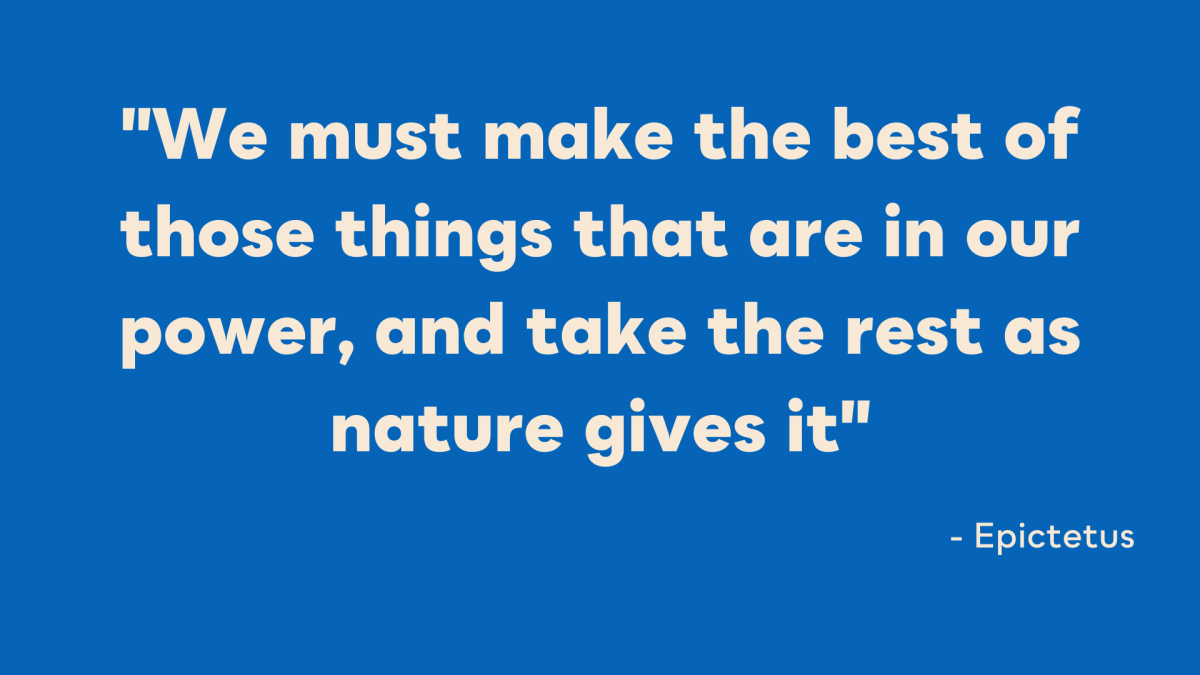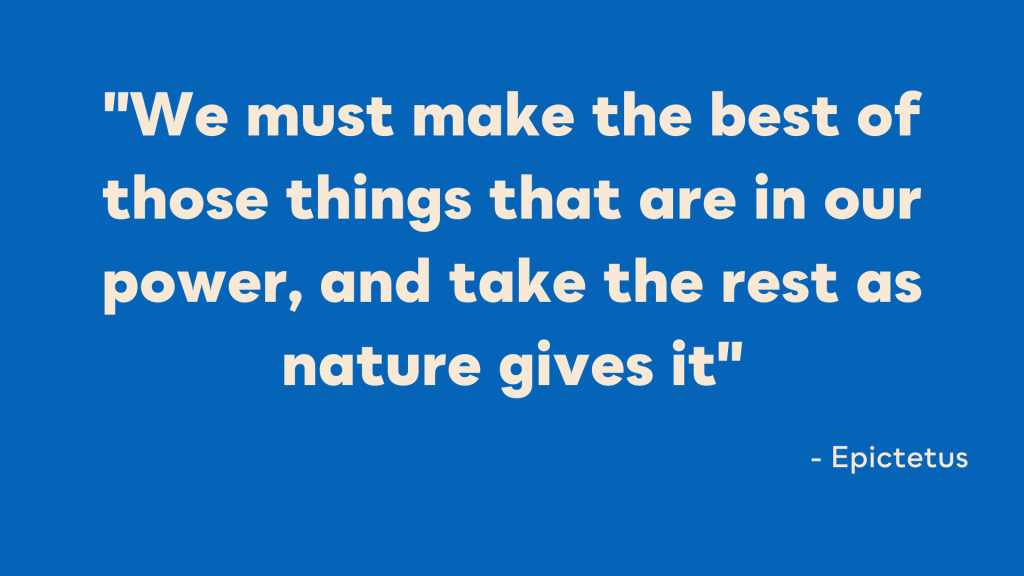Ahead of Creative Space’s mindfulness month, team member Jenna Macrory shares her thoughts on using Stoicism as a method of mindfulness for creating.
Note: Each of the following points could be an essay in its own right. It was extremely challenging whittling down such an expansive way of thinking into a few points. Although I’m an avid fan of Stoicism I am no expert. What I do not what the following text to be interpreted as is me preaching an approach to being creative (although I hope you do find elements of it you can employ in your own life). This is simply an account of how I use this thinking in my own practice
As a teenager, I used to wish there was a way to know how to make the “right” decisions. I would get incredibly overwhelmed and often burnout because of the pressure I placed on trivial matters. Then I encountered Stoicism, an ancient school of philosophy emerging in the third century B.C.
Initially developed by the Greeks and expanded on by the Romans this approach to life became incredibly beneficial for me because it provided a set of logical rules to live my life by. Stoic teachings made sense of the difficult times and provided me with a way to navigate life’s complexities. As I’ve progressed through my musical career I find myself turning to the ancient teachings as a way to navigate a highly competitive sector.
One of the most common misconceptions about Stoicism is that it is simply about remaining stoic. Rather than being concerned with enduring hardship Stoic thinking is about facing these difficulties head-on by identifying what is, and what is not in your control. Roman Orator Cicero offers the analogy of an archer shooting an arrow to aid us in comprehending this:
“Take the case of one whose task it is to shoot a spear or arrow straight at some target. One’s ultimate aim is to do all in one’s power to shoot straight, and the same applies with our ultimate goal. In this kind of example, it is to shoot straight that one must do all one can; none the less, it is to do all one can to accomplish the task that is really the ultimate aim. It is just the same with what we call the supreme good in life. To actually hit the target is, as we say, to be selected but not sought.”
The archer can do everything within his control to hit the target, from strenuous training to the selection of adequate weaponry but despite this, there are still variables once the bow leaves the arrow. The shooting of the bow is in the archer’s control but the arrow colliding with the intended target is never guaranteed. This is extremely relevant for the majority of creatives in our modern world.
When I release a song there are many factors within my control including the sound of the track and the marketing but alas this does not guarantee the commercial “success” of the song. The number of times my song is streamed or shared is not something I control even though I have aimed for my personal goals. I have selected my target but it is not sought after.
This brings us to my next point, who are you making your art for? To illustrate this point I would like to reference the Byzantine Military Commander Belisarius. Born in 500 A.D., Belisarius accomplished a plethora of notable military conquests in his life including recapturing Rome following the demise of the Western Roman Empire. One would expect a commander of this calibre to be adorned with military accolades but contrary to this Belisarius was condemned by the paranoid emperor that ruled over him. Emperor Justinian the first grew suspicious of Belisarius and his achievements were underwritten by bad politics which eventually led to him being tried and convicted for conspiring against the Emperor. The irony of this is that Belisarius had the opportunity to cease the throne multiple times but he chose not to. He identified that this was not his path, it was not his work and he took pride in the career that he did have. He showed up, he did his job and he expected nothing more.
Despite historians and scholars criticising Justinian’s treatment of Belisarius, according to records, he was not one to complain about his poor treatment. Although extreme examples of Stoic values such as this are not uncommon in the Classical Era, they are highly applicable to the situations many artists find themselves in. Belisarius was able to bypass the negativity associated with his circumstances because he was simply doing his job. He identified that not only did he not have control over how the Emperor may treat him but he knew that any additional praise that resulted due to his conquest was simply a bonus. This is how creating art should be.
Interpreting the Stoics it becomes evident that the purpose of creating music or any art form is not to receive praise. Any praise received is a bonus.
“Believe in your art and make art that is true to you and your ego will get out of your way.“
It is very easy to say all of this but from my experience with Stoicism, it is an intense philosophy to live by. It is not as easy as just being the best version of yourself it is naive to think it is this simple. Life often gets in the way but that is okay, it is okay to stumble and falter when we are trying to be better, and we can see this depicted by one of the world’s most prominent Stoics Marcus Aurelius:
“When jarred, unavoidably, by circumstance, revert at once to yourself, and don’t lose the rhythm more than you can help. You’ll have a better group of harmony if you keep on going back to it.”
New Year resolutions are the perfect antithesis of this quote. Too many of us are familiar with the process of setting an overly ambitious goal which will leave us disheartened when we inevitably give up because we are unable to incorporate our new goals into our lives in a healthy manner. Rather than reprimand ourselves for this, Aurelius conveys that this will be unavoidable at times and that is okay. But we should not give up. We should go back to our goals and approach them in a manageable way. Before utilising Stoicism in my practice I would spend long days at my computer making music before getting frustrated because I had not produced any quality work. This would result in long hiatuses from music-making which would make returning to composing incredibly daunting. Now instead of pressuring myself into long sessions, I dedicate two or three hours every night to making music. It is a healthy part of my schedule although I do also have a social life which does often result in socialising during this time. Although I am strict with my music-making when I miss a session I do not get frustrated at the fact I have not composed that day. Rather I recognise this, reflect and set the intention to compose the following day.
Despite history repeating, we tend to disregard the teachings of civilisations that came before us. Stoicism has guided many people since ancient Rome through life and as long as humanity remains it will continue to guide many more generations. Although Stoicism has been adopted by a variety of people it still seems absent in the creative industries. Through implementing Stoicism into your creative endeavours there is an opportunity to supercharge your art practice while becoming resilient to the mental strains of life.
How do you cope with the stress associated with being creative? Next week Creative Spaces launch their block of workshops on mindfulness. We’ll be launching this block of workshops with an open discussion on mindfulness next week (Thursday 3rd) at in The Stove Cafe from 7pm. If you’re under 30 and would like to attend you can register below:
For information on all our Creative Spaces Mindfulness Events check out our events here.


